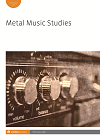-
f Heaviness and the electric guitar: Considering the interaction between distortion and harmonic structures
- Source: Metal Music Studies, Volume 4, Issue 1, Mar 2018, p. 95 - 113
-
- 01 Mar 2018
Abstract
In metal music studies, ‘heaviness’ has been acknowledged as an essential element of the genre. Commonly associated with the distorted guitar, most work on heaviness has concentrated on the instrument’s sound. If respective research considered structural aspects of the guitar riff, it did so with a special focus on tempo, rhythm, tonality and form. This article analyses the interaction between distortion and harmonic structures on the electric guitar. Operationalizing heaviness with a psychoacoustic model of sensory consonance, an acoustic experiment explores how guitar distortion affects acoustic features of harmonic structures. Since acoustic studies are limited in predicting perception, a listening test investigates distortion’s influence on listener perception. The findings indicate that both increasing distortion level and harmonic complexity reduce sensory consonance, especially when acting together. Acoustically, distortion has a slightly stronger effect than structure; perceptually, the ratio is dependent on person-specific characteristics. Metalheads seem to be only marginally affected by sensory dissonance.


